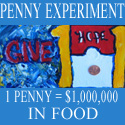I have always believed that if you have a goal which you are committed to achieving, there are creative ways to make it happen. It is through this creativity that I have been able to overcome the first major obstacle on making this experiment work.
After finding the original penny on the ground and deciding to try and turn it into $1 million worth of food for food banks, I sold it for $10 and then turned that $10 into 1000 pennies. I took 100 of those pennies and had 100 artists create artwork out of them. I then ran into a dilemma of how to sell the artwork.
This dilemma has been solved by selling a 50% stake in the penny postcard art collection for $1000 to Dana Hughes who made me a convincing business proposition when she heard about the problem I was having. Instead of an either “sell the artwork now” or “sell the artwork later” scenario, Dana asked why don’t I sell the artwork now and later? Instead of selling the individual artwork, sell a 50% stake in the entire collection and it will solve a number of the issues I considered a dilemma. As with everything I’ve tried to do with this experiment so far, this move should be a win-win situation for everyone involved.
It’s a win for the artists because their artwork will get more exposure on this website. Not only will it get posted when I receive it, it will also get more exposure when when it’s displayed in art galleries and eventually auctioned off. It will also be be displayed for sale for a much longer period of time letting more people become familiar with the work and the artist. Finally, it should mean that the total amount raised from each piece of artwork that goes to the food banks will be more than if I sold the pieces individually on my own right now.
It’s a win for the couponers because they don’t have to sit around waiting and wondering when the artwork is going to sell so that they can put their couponing skills to use. Since I have the money now in hand, they can begin their couponing when it is convenient for them instead of the other way around.
It is a win for the food banks because they will begin getting food sooner than if I waited to sell the artwork. At the same time, they should end up with more food than if I sold it early because I can sell the artwork again at a later date when it should have more people interested in it.
It’s a win for Dana because it is an investment that could turn a tidy profit for her in the long run in return for a $1000 investment now. If the art is eventually sold for a decent amount of money, she will be entitled to 50% of the selling price since she is now the owner of 50% of the artwork.
For me it’s a win because I solve the dilemma of trying to sell the art now for less money or for more later, but not having any money now to purchase food for food banks. With the $1000 in pocket, I can start having couponers buy food, and I don’t have to wait for individual pieces of work to be sold. I can also arrange for a gallery showing and art auction at a later date where the art can produce even more money for the food banks a second time around. Having $1000 in hand now also frees up time in not having to sell each piece individually on my own so that I can begin working on how to convert the next 100 pennies into money to buy food for food banks.
By selling a 50% stake in the artwork, I now have $1009 ($1000 for the artwork stake and 900 pennies still from the $10 I sold the original penny for). This is a very exciting solution to a problem that I thought was going to cause a lot of issues and stumbling blocks to make Penny Experiment work. I’m excited that I can actually begin to apply the couponing lessons I have been studying and start giving food to the food banks come the New Year.





3 Responses to One Penny Becomes $1009